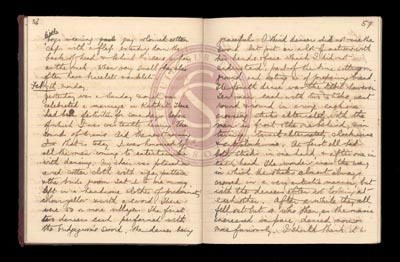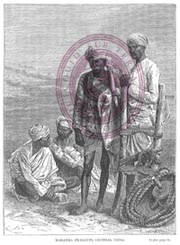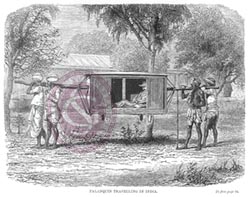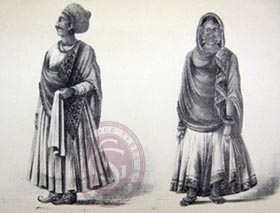 |
|
Diary (1902-1904): 8th-9th February 1903 (p.56-57) [LDGSL/348/2/3]. Click to enlarge.
|
In typical colonial fashion, Fermor appeared to treat the natives of the country as interesting, but very much inferior, beings. He describes their daily activities, religious observances, and dancing, but does not consider them real company – in the article for the Royal College of Science Magazine, he goes so far as to suggest that insects are more genuine company than Indians:
[E]ven though there is not another white man within a distance of many miles, one need not feel the lack of companions, for at dinner I have often seen representatives of every order of insect on my table or the walls of the tent, attracted by the lamplight.
Fermor 1903, p.276
 |
| Native Maratha peasants. The Maratha caste are mostly found in the Maharashtra region, where Fermor spent time during his second field work season. [George Smith, Stephen Hislop: Pioneer Missionary & Naturalist in central India from 1844 to 1863, London: John Murray, 1888 (p.81).] |
He deems his Indian servants lazy, saying they had ‘made an excuse for sleeping on the way’ (Fermor 1903, p.208) when a cart broke a wheel, despite the fact that they were expected to transport all the camping equipment, cook, keep watch at night, carry his geological equipment in the daytime, and even occasionally carry him across rivers, all of this often done in dense and hilly forest. One diary entry begins by Fermor stating he went to dig a trench, but in reality his servants were required to do so:
Today I went to make a trench for Mn ore in a nala [stream] near Kanar [Kanad] just the other side of a Deccan Trap hill, making use of 4 coolies, who took 3½ hours to make a trench 15ft. long, 2 broad and 1½-2ft. deep. They took it in turns to rest.
23rd January 1903
He does, however, record in his diary the names, religions, hometowns, and roles of his six principal servants at the end of his first field work season, and mentions them travelling on the train with him as he departed Harda, with them leaving the train for their homes at various points throughout the journey. He engaged these servants to fulfil certain roles for the whole season, while other casual servants – called coolies – would be obtained for a short while from various villages along the way.
He also describes, sometimes in detail, the activities of Indian villagers he observed on his travels. He saw women carrying out domestic tasks such as weaving, cooking, or, in this case, distilling alcohol:
I should notice that the mahua is now in full bloom and women and children are gathering the fallen flowers. In this village I saw them engaged in distilling daru from last year’s flowers. These are allowed to ferment in pots in their own water and then distilled over a copper vessel heated over a wood fire [...]. The spirit is condensed by pouring water on the outside of an earthen pot inverted over the copper vessel and joined to latter by a neck of cloth and string. The liquid runs down a bamboo tube into an earthen pot.
16th March 1904
 |
| A white man travelling in a palanquin carried by Indians. While Fermor does not mention travelling in this way, it demonstrates the wider relationship between Indians and colonial settlers. [George Smith, Stephen Hislop: Pioneer Missionary & Naturalist in central India from 1844 to 1863, London: John Murray, 1888 (p.94).] |
There is only one obvious instance of conflict, or anti-British sentiment, recorded in Fermor’s diary. A ‘young student’ in the village of Kantaphor (Kantaphod) ‘accosted [Fermor] in English and spoke of the unsympathetic attitude of the majority of the English officials towards the natives and the lack of interest in their affairs and customs’ (9th March 1903). Fermor could certainly not be accused of a lack of interest, with diary entries including sections such as those above, and this, on a local custom:
While at this place took place “gur tarneks” literally “breaking the sugar”. I did not see it but was told that the women of the village put 1¼ Rupees and 1¼ seers[?] of “gur” in a piece of cloth, on top of a thick pole. Then any man who likes can take the trophy, if he will undergo the ordeal of climbing up the pole, while the women whack him with sticks as much as they like. I was told that the man who succeeded climbed up as quickly as he could, secured the booty, jumped down, and ran away.
2nd April 1903
 |
| High ranking Hindus in full winter dress. Fermor was travelling during the winter months, and may have seen costumes such as these. [Montgomery Martin, The History, Antiquities, Topography and Statistics of Eastern India. Vol.II – Bhagulpoor, Goruckpoor, and Dinajepoor, London: Wm.H. Allen & Co., 1838 (p.i).] |
He could, perhaps, be classed as unsympathetic – in the sense that it can seem that he didn’t respect Indians and their lifestyles. While he writes about their religious festivals and practices, such as Hindus worshipping Surya, the sun deity, in the river, ‘which they did by looking towards the sun, holding some water in the hands and muttering some words – which done they threw the water back’ (5th May 1904), he does not respect their sacred sites. Describing a hill upon which he found a number of clay horses, Fermor states that ‘[t]hey were all more or less broken except one which I appropriated’, before recording that they were there because ‘whenever anyone’s child was very ill the person made an offering’ (7th December 1903) – making this an act of cultural insensitivity that would probably be frowned upon today.